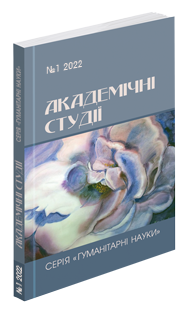Abstract
The authors of the article consider the translation of fiction text as one of the most effective forms of intercultural communication of a foreign author and reader, a way to convey his creative ideas by linguistic and psychological means. It is emphasized that in the process of translating a fiction text from English into Ukrainian there is a high probability of a number of difficulties due to numerous divergences, which are primarily because of the belonging of two languages to different groups and, consequently, the existence of different grammatical categories. Therefore, the need to overcome the barrier of divergences in the original language and the language of translation, to achieve adequacy and maximum reliability determines the need for translation transformations, including grammatical ones. Analysis of the factual material makes it possible to conclude that in most cases the transformations used by V. Morozov in the process of translating Roald Dahl’s “Matilda” are justified. The translator uses all kinds of grammatical transformations. Transformations of internal division, replacement, permutation and transposition are most often used; less often, there are integrations and compensations. At the same time, it can be argued that the volume of grammatical transformations aimed at achieving the adequacy and semantic equivalence of literary translation, in addition to subjective and objective factors is also significantly influenced by the norms of the Ukrainian language. Therefore, a key component of a translator’s professional competence and a guarantee of quality is a thorough knowledge of the native language, its basics, features and subtleties, as well as awareness of current trends, changes and innovations.
References
Гришкова Н. В. Концепт як мовно-культурний феномен. Наукові записки Національного університету «Острозька академія». Серія : «Філологічна». 2009. Вип. 11. С. 187–193.
Комиссаров В. Н. Теория перевода. М.: Высшая школа, 1990, 80 с.
Науменко Л. П., Гордєєва А. Й. Практичний курс перекладу з англійської мови на українську : навч. посібник. Вінниця : Нова книга, 2011. 136 с.
Шишко А. В., Луканська Г. А. Граматичні трансформації в художньому перекладі. Науковий вісник Міжнародного гуманітарного університету. Сер.: Філологія. 2019. № 43. Т. 4. С. 125–128.
Швейцер А. Д. Перевод и лингвистика. М.: Высшая школа, 1973. 310 с.
Ostapenko S. A., Lysohor M. Yu. Emotionally expressive lexical units rendering in the process of fiction text translation (based on material from “Matilda” by Roald Dahl). Інтелект. Особистість. Цивілізація: Тематичний збірник наукових праць із соціально-філософських проблем. № 2(23). 2021. C. 61–69.
Дал, Роальд. Матильда / пер. з англ. В. Морозов. Київ: А-БА-БА-ГА-ЛА-МА-ГА, 2018. URL: https://readli.net/ chitat-online/?b=409218&pg=1
Dahl, Roald. Matilda. Puffin Books. 2016. URL: https://archive.org/stream/matilda_20180915/matilda_djvu.txt

